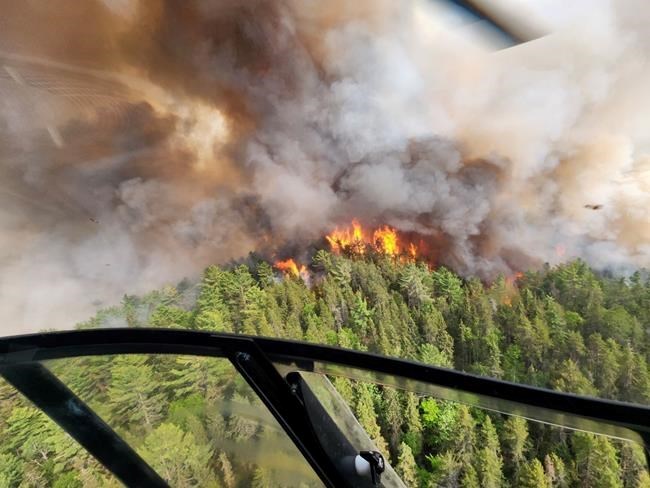Wildfire smoke that hung over Toronto for several days cleared Friday, resulting in a notable improvement in air quality, while communities in northern Ontario and western Quebec saw pollution warnings and hazy skies.聽
Environment Canada had no air quality statements in place for Toronto on Friday but issued several for parts of northeastern Ontario, including North Bay, Sudbury and Timmins, as well as parts of western Quebec.
"Those places are still under smoke from the forest fires," said Gerald Cheng, a warning preparedness meteorologist with Environment and Climate Change Canada.聽
"For places in the south, like Montreal, Ottawa and even much of southern Ontario, the conditions have improved."
Cheng predicted that some smoke would move back over southern Ontario and Quebec on the weekend but at lower concentration levels. Higher intensity concentrations of smoke are expected north of the St. Lawrence River, he said.
"We are looking at some showery conditions, so there is a chance of showers today, Saturday and even into Sunday," Cheng said.聽
Environment Canada has warned that people with lung or heart diseases, older adults, children, pregnant people and those who work outdoors are at a higher risk of experiencing health effects from the smoke.聽
However, the agency also noted that wildfire smoke can be harmful to everyone's health "even at low concentrations."
In Quebec, dozens of firefighters from France arrived to join the fight against more than 140 fires burning across the province. They headed to Roberval, in the province's Saguenay-Lac-St-Jean region, for a briefing before going to work, the province's forest fire prevention agency said.
Quebec Premier Fran莽ois Legault has said about 13,500 people had been forced from their homes as a result of the wildfires, and though the situation is expected to remain stable over the next couple of days, it's unclear when residents will be able to return home.
In Nova Scotia, most evacuation orders had been lifted on Friday following nearly two weeks of unprecedented wildfires in the southwestern corner of the province and in suburban Halifax.
While the largest wildfire in the province's history continued to burn out of control in Shelburne County, evacuation orders were lifted at noon since it hadn't grown since the weekend thanks to the work of firefighters and wet, cool weather. The fire forced more than 6,000 people from their homes and destroyed 60 homes and cottages.
Evacuation orders in the Halifax Regional municipality were all lifted an hour later, with the exception of a small portion of subdivisions closest to where the fire started.
In Alberta, the worst air quality was near Fort Chipewyan, which was on an evacuation order as a nearby fire burned out of control. Wood Buffalo and Grande Prairie also had high-risk air quality forecasts, while Edmonton and Calgary saw moderately bad air quality.
An out-of-control wildfire burning near the small Dene community of Sambaa K'e in the Northwest Territories is believed to have destroyed two cabins last week, the territory's wildfire agency said. The fire had burned an estimated 2,650 square kilometres by Friday afternoon.
In British Columbia, air quality improved almost everywhere except for areas around Fort Nelson, Stone Mountain Park, Williston and the Peace River district.
Forecasters said showers on Saturday could sprinkle an aggressive wildfire that forced more than 2,000 people from their homes in northeastern B.C., but thunderstorms could sweep the region before any rain arrives. That could complicate efforts to fight the West Kiskatinaw River wildfire, which has burned 96 square kilometres in the three days since being discovered.
More than 43,000 square kilometres have burned in Canada so far this year, making 2023 the second-worst year for fires on record. That's before the hottest months of the year have even begun.聽
In 1995, 71,000 square kilometres burned, the most ever in a single year. The pace of burning at the moment has Canada on track to surpass that total before the end of June.
This report by The Canadian Press was first published June 9, 2023.
The Canadian Press
Note to readers: This is a corrected story. A previous version said the largest area burned from wildfires in Canada in 2014.




